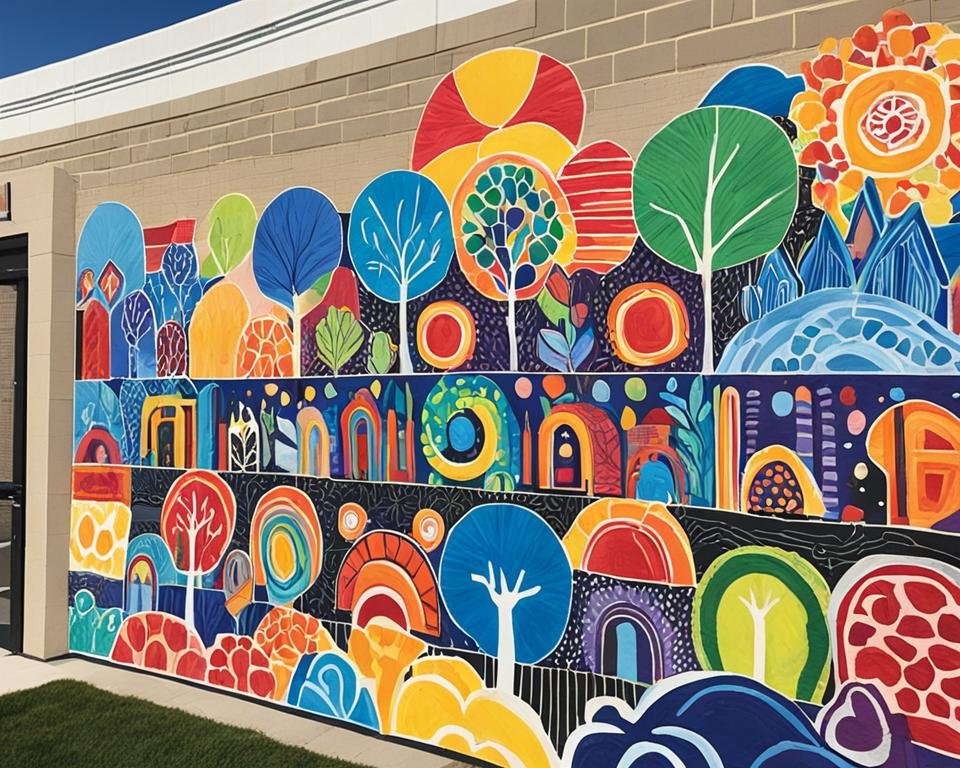As an educator, I recognize the immense value that creative education programs can bring to the learning experiences of our students. These programs not only foster creativity and innovative thinking, but they also provide invaluable opportunities for students to engage with their local communities and gain practical, real-world skills. One of the key aspects I’ve observed is the power of community-based projects to enhance student learning and foster a deeper connection between the classroom and the world beyond its walls.
Funding, however, can often be a significant challenge when it comes to implementing and sustaining these types of programs. To address this, I’ve found that establishing a dedicated creative programs fund in partnership with local charities and organizations can be a game-changer. This fund can serve as a quality control mechanism, ensuring that the projects undertaken provide rich, practical learning opportunities for students while also delivering positive social, environmental, and cultural benefits for the community.
Some of the most successful models for community-based projects that I’ve seen include co-creating local exhibitions and shows, working closely with local media outlets, contributing to community festivals and events, and even providing professional advisory services. These initiatives not only engage students in meaningful, hands-on learning but also allow them to make tangible contributions to the communities in which they live.
Key Takeaways
- Community-based projects can enhance student learning and provide practical experience while benefiting local communities.
- Establishing a dedicated creative programs fund in partnership with local organizations can help address funding challenges.
- Successful community-based project models include co-creating local exhibitions, working with media outlets, contributing to community events, and providing professional advisory services.
- These projects can serve as a quality control mechanism, ensuring rich learning opportunities and positive community impact.
- Leveraging community partnerships and resources can be a key strategy for expanding and sustaining creative education programs.
The Importance of Fostering Creativity in Education
In today’s rapidly evolving world, creativity has become an increasingly valuable asset. Fostering creativity in the classroom can not only unlock students’ innovative potential but also help them develop essential life skills that will be crucial for their future success. By integrating creative education programs, innovative learning methods, and a student-centered approach, educators can empower students to think divergently, express themselves freely, and tackle complex problems with a fresh perspective.
Nurturing Essential Life Skills
Engaging students in project-based learning, experiential education, and interdisciplinary studies can cultivate a range of essential life skills, such as effective teamwork, problem-solving, and the ability to adapt to changing circumstances. By encouraging students to explore their creativity, educators can help them develop the agility and resourcefulness needed to thrive in the modern workforce.
Encouraging Self-Expression and Emotional Health
Creativity also plays a vital role in fostering self-expression and emotional health. Artistic exploration and imaginative curriculum can provide students with a safe space to explore their feelings, build self-confidence, and cultivate a deeper understanding of themselves and the world around them. This, in turn, can lead to improved mental well-being and enhanced engagement in the learning process.
Promoting Critical Thinking and Problem-Solving
At the heart of creative education lies the development of critical thinking and problem-solving skills. By incorporating innovative learning methods, arts-based curriculum, and design thinking approaches, educators can encourage students to question assumptions, think outside the box, and find unique solutions to complex challenges. These skills are invaluable in preparing students for the personalized learning pathways and maker education that will define their future.
As we navigate the demands of the 21st century, the importance of fostering creativity in education cannot be overstated. By empowering students to explore their imaginative curriculum and unlock their creative potential, educators can equip the next generation with the skills and mindset necessary to thrive in an increasingly complex and ever-changing world.
Creating a Conducive Learning Environment
The foundation of a truly creative education program lies in the environment that fosters innovation, imagination, and critical thinking. By carefully curating the classroom layout and incorporating open-ended assignments, educators can unlock the creative potential of their students and inspire them to explore, experiment, and problem-solve in meaningful ways.
Flexible Classroom Layouts
A flexible classroom layout that caters to diverse learning styles can be a powerful tool in nurturing creative education programs. Providing a range of seating options, from traditional desks to cozy nooks and flexible collaboration areas, allows students to find the spaces that best suit their innovative learning preferences. This freedom of choice encourages project-based learning and experiential education, where students can move freely, engage in hands-on activities, and tap into their artistic exploration.
Incorporating Open-Ended Assignments
In contrast to traditional rote-learning approaches, student-centered open-ended assignments can stimulate interdisciplinary studies and imaginative curriculum. These assignments often present multiple pathways to a solution, encouraging students to think critically, design thinking, and personalize their learning journey. By embracing innovative learning methods and arts-based curriculum, educators can foster a classroom environment that celebrates maker education and the exploration of diverse creative education programs.
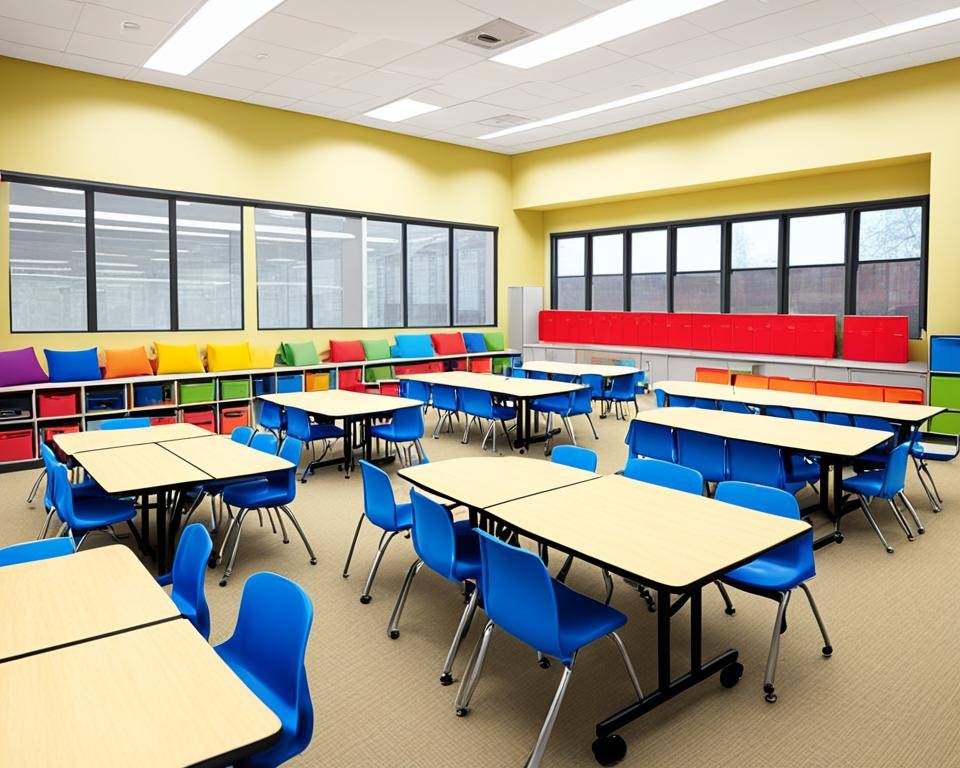
| Flexible Classroom Layout | Open-Ended Assignments |
|---|---|
| Provides options for different learning styles | Encourages critical thinking and personalized learning |
| Supports project-based and experiential learning | Promotes interdisciplinary studies and imaginative curriculum |
| Facilitates hands-on activities and artistic exploration | Embraces innovative learning methods and arts-based curriculum |
Engaging Students Through Creative Projects
Engaging students in community-based projects can enhance their learning, foster creativity, and provide practical experience. By immersing students in real-world scenarios, these projects allow them to apply their knowledge or creative skills in a professional context, while also benefiting local communities.
Co-creating Local Exhibitions and Shows
One successful model involves students collaborating with local artists, museums, or galleries to co-create exhibitions and shows that showcase their artistic exploration and imaginative curriculum. These projects not only provide students with hands-on project-based learning experience but also give them a platform to share their talents with the broader community.
Contributing to Community Events and Festivals
Students can also contribute their creative education programs and innovative learning methods to local community events and festivals. Whether it’s designing promotional materials, performing on stage, or leading interactive workshops, these opportunities allow students to engage in experiential education and student-centered approach while making a positive impact on their community.
Providing Professional Advisory Services
Another way to engage students is by connecting them with local businesses or organizations that need design thinking or maker education expertise. Students can provide professional advisory services, such as branding, product design, or digital marketing, gaining valuable interdisciplinary studies and personalized learning pathways experience.
These creative projects not only enrich the learning experience for students but also foster a strong sense of community engagement and social responsibility. By collaborating with local partners, students can develop essential life skills, such as critical thinking and problem-solving, while making a meaningful contribution to their community.
Funding and Resource Considerations
Establishing a dedicated creative programs fund in partnership with local charities and organizations can be a strategic approach to address the funding challenges often faced by creative education programs. This fund can serve as a quality control mechanism, ensuring that the projects undertaken provide valuable learning opportunities for students and meaningful positive impact for the community.
Partnering with local organizations can also help secure additional resources and support for the implementation of innovative learning methods and arts-based curriculum. By fostering these collaborative relationships, schools can tap into a wider network of expertise, funding sources, and community engagement opportunities to further enhance their creative education programs.
| Funding Approach | Benefits |
|---|---|
| Dedicated Creative Programs Fund |
|
| Partnerships with Local Organizations |
|
By leveraging these funding and resource strategies, schools can create a sustainable framework for innovative learning and personalized learning pathways that empower students to unlock their creative potential.
Integrating Creative Education Programs Across Disciplines
Integrating creative education programs across diverse disciplines can cultivate a more holistic and engaging learning experience for students. By incorporating creative projects and artistic exploration into various subject areas, educators can provide valuable opportunities for interdisciplinary studies and encourage students to apply their imaginative curriculum and innovative learning methods in a wide range of contexts.
This student-centered approach to project-based learning and experiential education allows learners to develop a deeper understanding of how creative education programs can complement and enhance their studies in subjects like science, mathematics, literature, and history. By fostering this design thinking mindset, students can unlock their creative potential and hone essential life skills such as problem-solving, critical thinking, and effective communication.
Through maker education and arts-based curriculum, students can explore personalized learning pathways that align with their unique interests and strengths. This interdisciplinary approach not only sparks innovative learning but also cultivates a deeper appreciation for the interconnectedness of various academic disciplines, preparing students for success in an increasingly complex and rapidly evolving world.
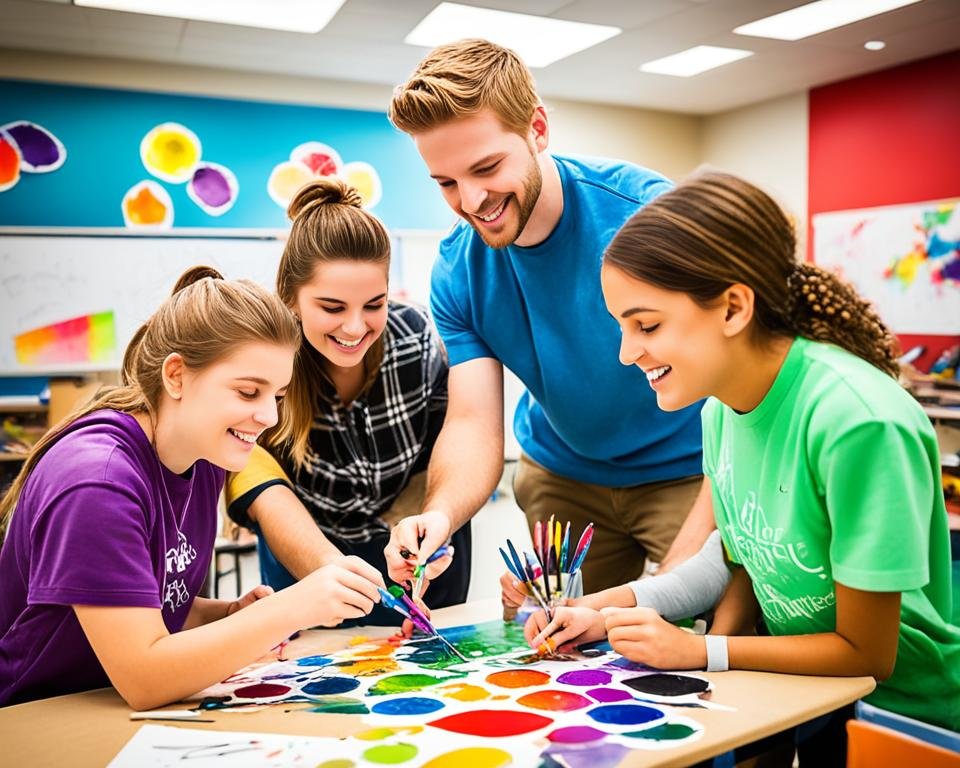
| Discipline | Creative Education Integration |
|---|---|
| Science | Incorporating design thinking and hands-on experiments to encourage innovative problem-solving |
| Mathematics | Exploring the creative applications of math through data visualization, coding, and mathematical art |
| Literature | Encouraging creative writing, multimedia storytelling, and literary adaptations |
| History | Engaging students in historical reenactments, museum curation, and documentary filmmaking |
By seamlessly integrating creative education programs across disciplines, educators can cultivate a dynamic and enriching learning environment that empowers students to become innovative thinkers and lifelong learners. This interdisciplinary approach not only fosters artistic exploration and imaginative curriculum but also prepares students for success in an ever-evolving global landscape.
The Role of Educators in Nurturing Creativity
Educators play a pivotal role in fostering creativity within the classroom. By modeling creative behavior, providing constructive feedback, and encouraging collaboration and group work, teachers can cultivate an environment that promotes creative thinking and self-expression among their students. Encouraging students to explore solutions on their own, rather than rushing to provide the answers, can also help develop their creative problem-solving skills, essential for success in the modern world.
Modeling Creative Behavior
As role models, educators can demonstrate their own creative capacities, showcasing how they approach challenges with an innovative mindset. By sharing their creative process, teachers can inspire students to embrace creative exploration and experimentation, ultimately unlocking their creative education programs and innovative learning methods.
Providing Constructive Feedback
Offering thoughtful and constructive feedback is crucial for nurturing creativity in students. Educators should provide guidance that encourages students to take risks, explore new ideas, and learn from their mistakes. This approach fosters a student-centered approach to learning, empowering students to become confident and self-directed in their personalized learning pathways.
Encouraging Collaboration and Group Work
Collaborative and group-based learning experiences can be powerful catalysts for creativity. By fostering an environment that encourages interdisciplinary studies and project-based learning, educators can help students develop essential creative education programs and artistic exploration skills, such as communication, problem-solving, and design thinking.
Ultimately, the role of educators in nurturing creativity is critical, as they have the power to inspire and empower students to become innovative, imaginative thinkers and problem-solvers, prepared to thrive in the rapidly evolving landscape of the 21st century.
Leveraging Technology and Online Resources
In the digital age, technology and online resources have become powerful tools for enhancing creative education programs. By leveraging these tools, educators can provide students with engaging and accessible ways to explore their creativity, fostering creative education programs, innovative learning, and project-based learning.
Utilizing Free Creative Tools and Platforms
Free online platforms and creative tools, such as Canva and YouTube, offer a wealth of resources for students to express their creativity. These platforms allow users to design eye-catching visuals, create multimedia content, and share their work with a wider audience, all while honing their experiential education and artistic exploration skills.
Incorporating Multimedia and Visual Elements
Integrating multimedia and visual elements into lesson plans and project-based learning can be a powerful way to stimulate creative thinking and expression. By incorporating student-centered approach, interdisciplinary studies, and imaginative curriculum, educators can encourage students to explore different modes of communication and representation, ultimately enhancing their innovative learning methods and arts-based curriculum.
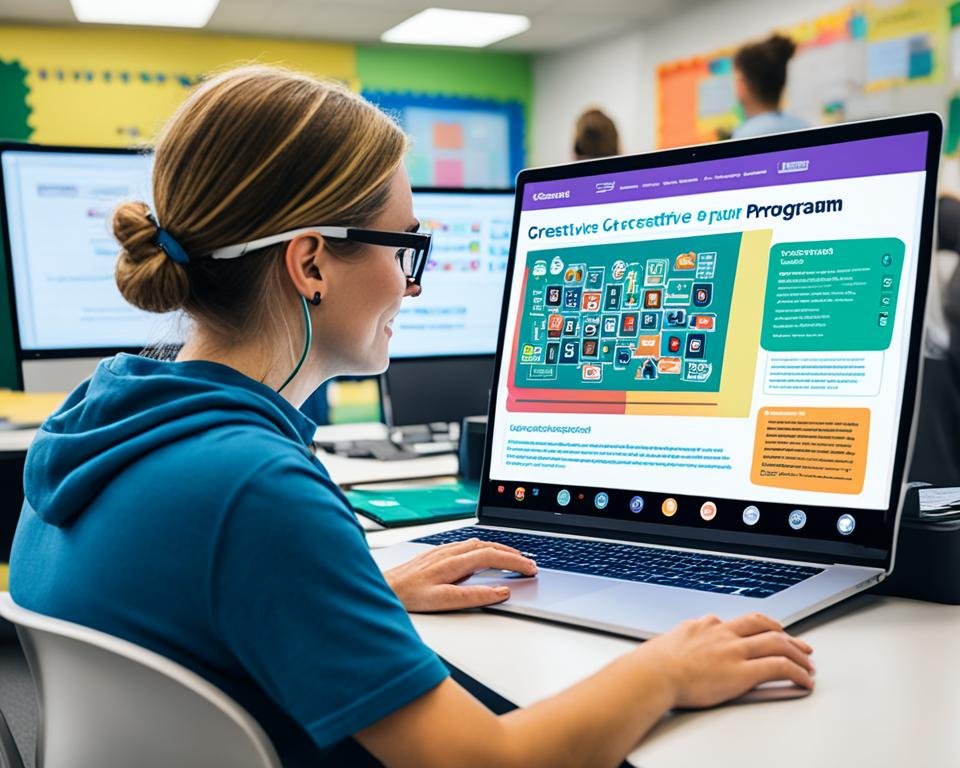
By harnessing the power of technology and online resources, schools can create a dynamic and engaging learning environment that fosters maker education, design thinking, and personalized learning pathways. This approach empowers students to develop their creative skills while also preparing them for the digital and innovative landscape of the future.
Creative Education Programs
Creative education programs are essential for fostering creativity, critical thinking, and problem-solving skills in students. By providing a range of engaging and hands-on learning opportunities, such as community-based projects, open-ended assignments, and interdisciplinary studies, these programs can help students develop essential life skills and unlock their creative potential.
Through project-based learning and experiential education, students are encouraged to explore their creativity and put their artistic exploration skills into practice. This student-centered approach to learning allows them to take an active role in their education, which is crucial for cultivating the imaginative curriculum and innovative learning methods needed to thrive in the modern world.
By incorporating arts-based curriculum and maker education, these programs foster a deep appreciation for the creative process and the development of design thinking and personalized learning pathways. This holistic approach to education empowers students to become confident, innovative, and adaptable problem-solvers, prepared for the challenges of the future.
Building Partnerships and Community Engagement
Forging strong partnerships with local media outlets and community organizations can be a valuable strategy for enhancing creative education programs. Collaborating with local media can provide students with invaluable opportunities to gain practical experience in research, content creation, and community storytelling. By working alongside journalists and media professionals, students can hone their communication skills, deepen their understanding of the creative process, and contribute meaningful stories that resonate with the local community.
Working with Local Media Outlets
Establishing partnerships with local newspapers, radio stations, and television channels can open up a wealth of possibilities for creative education programs. Students can participate in media-related projects, such as conducting interviews, producing podcasts, or creating short films that highlight the innovative work happening in their classrooms. These collaborations not only give students a platform to showcase their talents but also foster a deeper connection between the school and the surrounding community.
Establishing Connections with Community Organizations
Connecting with local community organizations, such as cultural centers, arts councils, and non-profit groups, can lead to meaningful project-based learning opportunities that benefit both students and the community. Students can contribute their creative skills and fresh perspectives to community initiatives, whether it’s designing promotional materials for a local festival, developing interactive exhibits for a museum, or providing design consulting services to small businesses. These partnerships not only enhance the students’ learning experience but also demonstrate the real-world impact of creative education programs.
By building these valuable partnerships, schools can tap into a wealth of resources, expertise, and opportunities that enrich the creative education landscape and foster a vibrant connection between the classroom and the local community.
Assessing and Evaluating Creative Program Outcomes
Regularly assessing and evaluating the outcomes of creative education programs is essential for continuous improvement and ensuring these initiatives effectively meet their goals. By gathering feedback from both students and community partners, educators can gain valuable insights into the program’s impact and identify areas for enhancement. Additionally, measuring the program’s effect on student learning, such as the development of critical thinking and problem-solving skills, can help demonstrate the value and effectiveness of these innovative learning methods.
Gathering Student and Partner Feedback
Obtaining feedback from the key stakeholders involved in creative education programs is crucial for understanding their real-world impact. Students can provide valuable insights into the engaging nature of the learning experiences, the development of their creative and analytical skills, and the overall level of satisfaction with the program. Likewise, community partners who collaborate on project-based learning or co-create local exhibitions and events can offer valuable perspectives on the practical benefits and social impact of the programs. By actively soliciting and analyzing this feedback, educators can refine their approaches to creative education programs, ensuring they continue to meet the evolving needs of students and local communities.
Measuring the Impact on Student Learning
In addition to gathering qualitative feedback, it is important to measure the tangible impact of creative education programs on student learning outcomes. This can involve assessing the development of critical thinking, problem-solving, and innovative learning skills, as well as the ability to apply project-based learning and experiential education methods in diverse contexts. By tracking student progress through formative and summative assessments, educators can demonstrate the value of artistic exploration, interdisciplinary studies, and imaginative curriculum in enhancing student achievement and preparing them for success in the modern, student-centered world.
| Feedback Source | Evaluation Metrics | Desired Outcomes |
|---|---|---|
| Students |
|
|
| Community Partners |
|
|
By regularly assessing and evaluating the outcomes of creative education programs, educators can ensure these initiatives continue to provide transformative learning experiences for students and valuable contributions to local communities. Through a comprehensive evaluation process that incorporates both qualitative and quantitative measures, schools can demonstrate the lasting impact of maker education, design thinking, and personalized learning pathways on student development and community engagement.
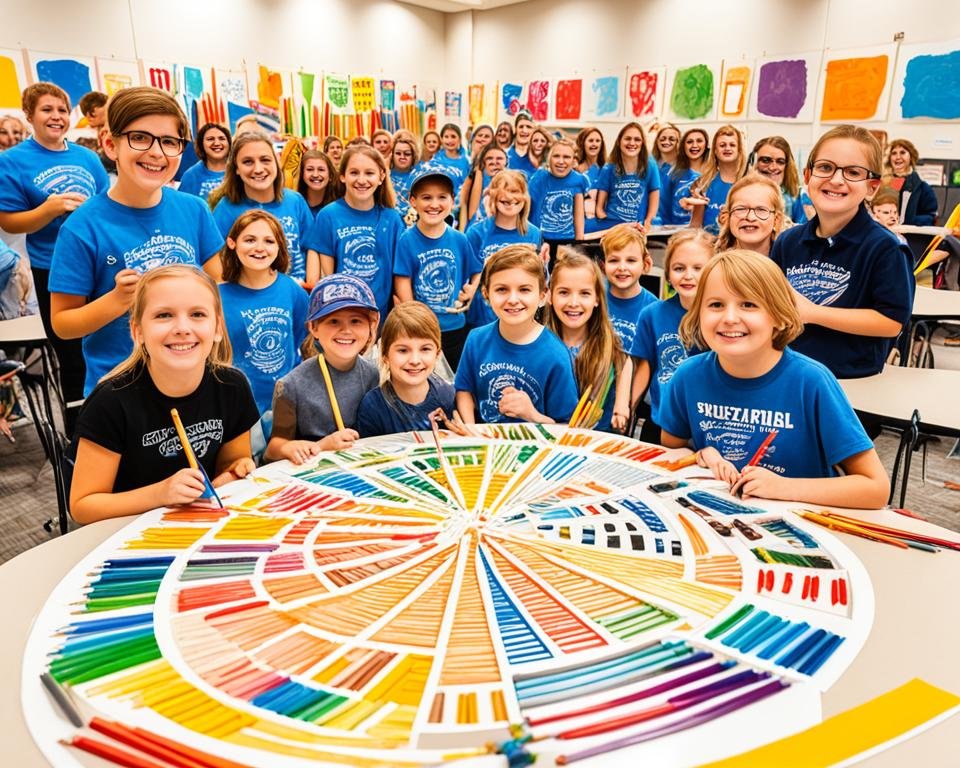
Conclusion
As we’ve explored, expanding creative education programs in schools is pivotal for cultivating essential life skills, nurturing self-expression and emotional well-being, and promoting critical thinking and problem-solving aptitude. By crafting a conducive learning environment, engaging students in community-based projects, leveraging technology and resources, and building meaningful partnerships, educators can unlock the creative potential of their students and prepare them for success in the dynamic, innovation-driven world they will soon inherit.
Through initiatives that foster creative education programs, innovative learning, project-based learning, experiential education, and artistic exploration, we can empower students to develop a student-centered approach to their studies, embrace interdisciplinary studies, and harness imaginative curriculum and innovative learning methods. This holistic, arts-based curriculum nurtures maker education, design thinking, and personalized learning pathways – equipping our youth with the skills and mindset necessary to thrive in the 21st century.
As we move forward, it is incumbent upon us as educators, policymakers, and community leaders to prioritize and champion these transformative creative education programs. By doing so, we can inspire a generation of creative problem-solvers, empathetic communicators, and engaged citizens – individuals poised to navigate the challenges of the future with confidence, compassion, and the innovative spirit that will propel our world towards a brighter tomorrow.

